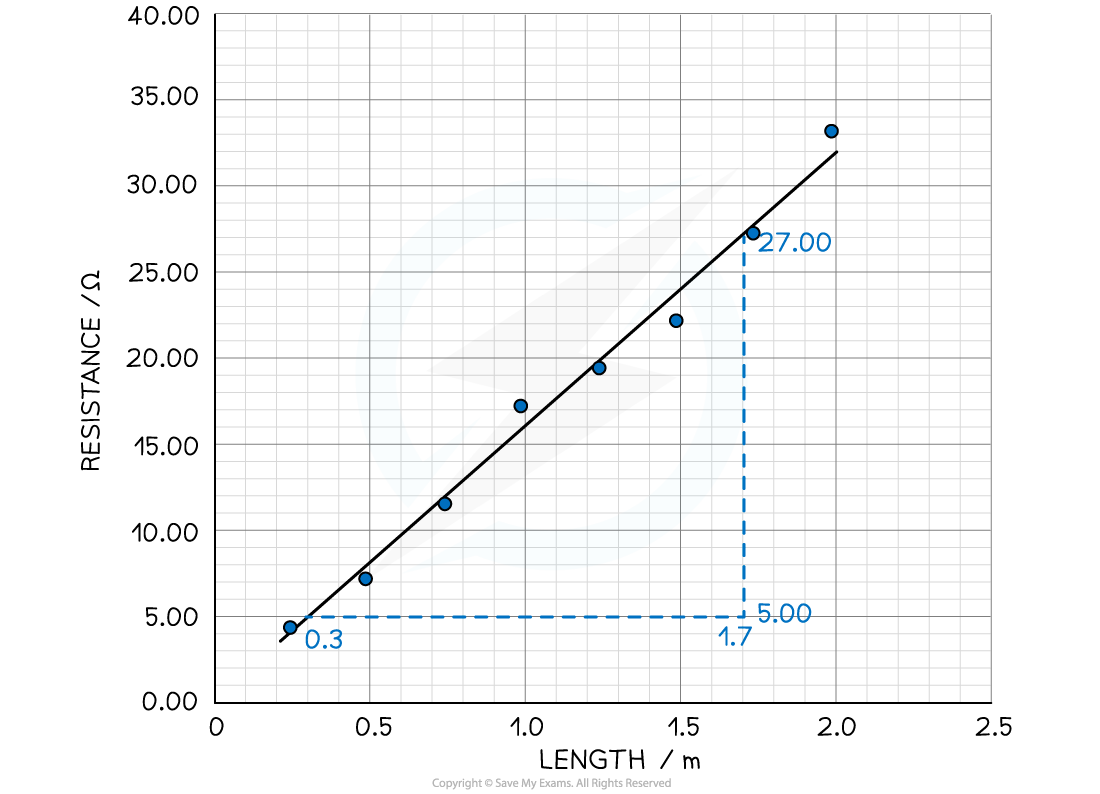Core Practical 2: Investigating Resistivity (Edexcel A Level Physics) : Revision Note
Core Practical 2: Investigating Resistivity
Aims of the Experiment
The aim of the experiment is to determine the resistivity of a length of wire
Variables
Independent variable = Length, L, of the wire (m)
Dependent variable = The current, I, through the wire (A)
Control variables:
Voltage across the wire
The material the wire is made from
Equipment List

Resolution of measuring equipment:
Metre ruler = 1 mm
Micrometer screw gauge = 0.01 mm
Voltmeter = 0.1 V
Ammeter = 0.01 A
Method

Measure the diameter of the wire using a micrometer.
The measurement should be taken between 5-10 times randomly along the wire.
Calculate the mean diameter from these values
Set up the equipment so the wire is taped or clamped to the ruler with one end of the circuit attached to the wire where the ruler reads 0.
The ammeter is connected in series and the voltmeter in parallel with the wire
Attach the flying lead to the test wire at 0.25 m and set the power supply at a voltage of 6.0 V.
Check that this is the voltage across the wire on the voltmeter
Read and record the current from the ammeter, then switch off the current immediately after the reading
This is to prevent the wire from heating up and changing the resistivity
Vary the distance between the fixed end of the wire and the flying lead in 0.25 m intervals (0.25 m, 0.50 m, 0.75 etc.) until the full length
In this example, a 2.0 m wire is used.
The original length and the intervals can be changed (e.g. start at 0.1 m and increase in 0.1 m intervals), as long as there are 8-10 readings
Record the current for each length at least 3 times and calculate an average current, I
For each length, calculate the average resistance of the length of the wire using the equation

Where:
R = average resistance of the length of the wire (Ω)
V = potential difference across the circuit (V)
I = the average current through the wire for the chosen length (A)
An example of a table of results might look like this:

Analysis of Results
The resistivity, ρ, of the wire is equal to
Where:
ρ = resistivity (Ω m)
R = resistance (Ω)
A = cross-sectional area of the wire (m2)
L = length of wire (m)
Rearranging for the resistance, R, gives:
Comparing this to the equation of a straight line: y = mx
y = R
x = L
Gradient, m = ρ / A
Therefore, to find resistivity:
Plot a graph of the length of the wire, L, against the average resistance of the wire
Draw a line of best fit
Calculate the gradient
Multiply the gradient by cross-sectional area, A

To calculate the cross-sectional area, A, of the wire
Evaluating the Experiment
Systematic Errors:
The end of the wire that is attached to the circuit (not the flying lead) must start at 0 on the ruler
Otherwise, this could cause a zero error in your measurements of the length
Random Errors:
Only allow small currents to flow through the wire
The resistivity of a material depends on its temperature
The current flowing through the wire will cause its temperature to increase
Therefore the temperature is kept constant by small currents
The current should be switched off between readings
So that there isn't a temperature rise
Calculate an average diameter
This will reduce random errors in the reading
Make at least 5-10 measurements of the diameter of the wire with the micrometer
Safety Considerations
When there is a high current, and a thin wire, the wire will become very hot
Do not touch the wire directly when the circuit is switched on
Switch off the power supply between readings, and immediately if you smell burning
Keep liquids away from electrical equipment
Worked Example
A student conducts an experiment to find the resistivity of a constantan wire.
They attach one end of the wire to a circuit that contains a 6.0 V battery. The other end of the wire is attached by a flying lead to the wire at different lengths.
They obtain the following table of results:

The following additional data for the wire is:

Calculate the resistivity of the wire.
Answer:
Step 1: Complete the average current and resistance columns in the table
The resistance is calculated using the equation

Step 2: Calculate the cross-sectional area of the wire from the diameter
The average diameter is 0.191 mm = 0.191 × 10–3 m
The cross-sectional area is equal to
Step 3: Plot a graph of the length L against the resistance R

Step 4: Calculate the gradient of the graph

Step 5: Calculate the resistivity of the wire

You've read 0 of your 5 free revision notes this week
Sign up now. It’s free!
Did this page help you?
